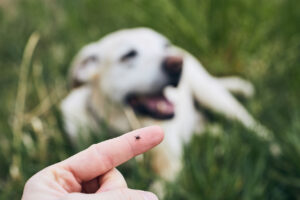Ticked Off? Learn How to Prevent Tick Bites and Stay Safe This Summer
Guest post by Thomas Marx, LMCIT loss control consultant
 Due to the relatively mild winter in Minnesota this year, it is anticipated that tick populations will be notably high this summer. June is a great time to review trainings on tick bite prevention, proper protective equipment, and tickborne diseases.
Due to the relatively mild winter in Minnesota this year, it is anticipated that tick populations will be notably high this summer. June is a great time to review trainings on tick bite prevention, proper protective equipment, and tickborne diseases.
Ticks generally stay active through the end of June and will become active again in the fall. Deer ticks and American dog ticks (“wood ticks”) are the two most common types in Minnesota. Both can potentially transmit diseases to humans and pets, with deer ticks posing a greater risk due to their ability to transmit Lyme disease.
Preventing a Tick Bite
Here are some tick bite prevention tips from the Minnesota Department of Natural Resources:
- Avoid walking in tall grass and brush. Use trails where available and walk in the center to avoid brushing against longer overgrowth.
- Wear light-colored clothing so ticks will be more visible.
- Create a barrier to ticks. Tucking your shirt into your pants and tucking your pants into your socks or boots can create a barrier between your skin and the ticks.
- Use repellent containing DEET or permethrin. Be sure to use care and follow the directions on the container.
- After being outdoors in tick habitat, change your clothes as soon as possible. Completely check over your body, shower, and vigorously towel dry. Be sure to wash your clothes immediately to prevent the spread of ticks in your living area.
- Be sure to check your pets after time spent outside. Not only can a tick bite cause harm to them, but pets can also transfer a tick to you or your living area.
What To Do If You Find a Tick Biting You
- Use a fine-tipped tweezers and grab the tick as close to the surface of your skin as possible. Pull straight upward with steady pressure and avoid crushing it.
- Do not twist or jerk the tick, this can cause the mouth parts to break off and remain in your skin.
- Once the tick is removed, be sure to thoroughly clean the bite area, use rubbing alcohol or soap and water.
- Pay attention to your body. If you develop a rash or flu-like symptoms, visit your doctor.
- Do not crush a tick with your fingers. Dispose of it by putting it in alcohol or flushing it down the toilet.
- If you would like to save the tick for identification by your health care provider, place it in a sealed bag/container or wrap it tightly in tape.
- If a tick bite occurs at work or was picked up on your body there, talk with your employer and consider filling out a first report of injury form.
Additional resources:
- Minnesota Department of Health – Ticks in Minnesota
- Minnesota Department of Health – Tick-Transmitted Diseases
- Minnesota Department of Health – Lyme Disease Overview
- Minnesota Department of Health – Tickborne Disease Prevention
- Minnesota Department of Health – Proper DEET and Permethrin Use (video)
- Minnesota Department of Health – How to Remove a Tick (video)
- University of Minnesota School of Public Health – Tick Poster
- University of Minnesota Extension – Ticks
- University of Minnesota – Talking tick season with the U of M
- Centers for Disease Control and Prevention (CDC) – Ticks

